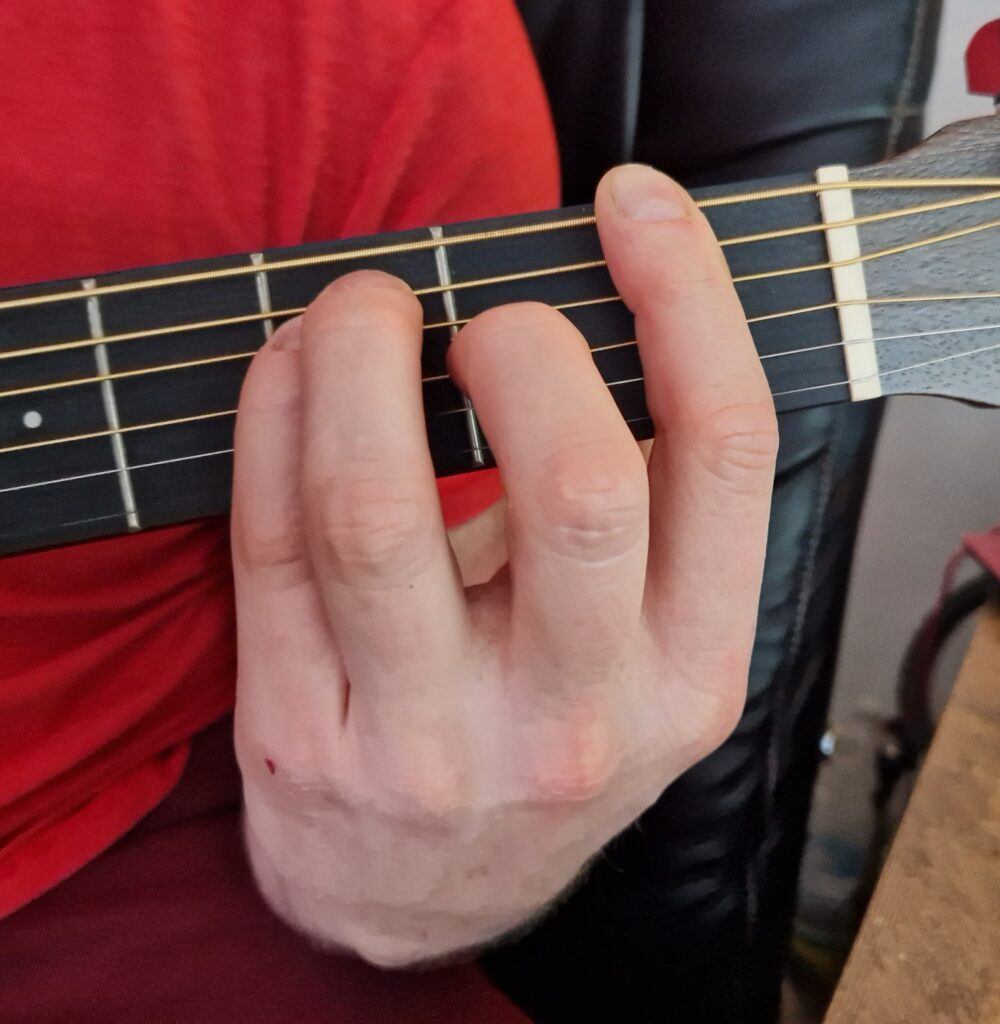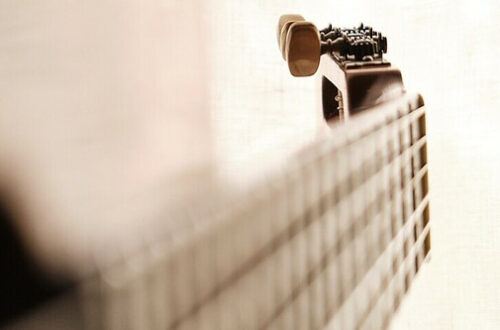
5 Barre Chords For Beginners
Barre chords are more than just a set of guitar chords; they are a gateway to expanding your musical repertoire and usually the chords you would learn after getting familiar with open chords.
Unlike open chords, which may confine you to the first few frets, barre chords allow you to play the same chord shape all along the fretboard. This little secret can take you from playing simple tunes to complex melodies. This is why I have chosen 5 Barre Chords for Beginners as a place to start.
You may wonder why you need to learn barre chords. The answer is quite straightforward. Barre chords enrich your sound by offering a wider range of notes and a fuller tone. Moreover, they are pivotal in many songs across various genres, making them an indispensable part of a guitarist’s toolkit.
By the end of this guide, you’ll have a solid understanding of what barre chords are, why they are an essential guitar skill, and how to begin implementing them into your playing. Whether you aspire to play rhythm or lead, mastering barre chords will put you leagues ahead in your guitar journey.
Table of Contents
Barre Chords Demystified: The Basics for Beginners

Consider barre chords a fundamental building block in your guitar journey. Much like constructing a house from the ground up, mastering these chords ensures your skills have a solid foundation. Unlike regular chords that often involve open strings, barre chords require you to press down multiple strings at once using one finger. It’s like using a bar across the fretboard, hence the name.
Utilising the Fretboard
These multipurpose chords stand out for their versatility. Barre chords are movable shapes, which means you can play the same shape up and down the fretboard to produce chords of different pitches. This is incredibly practical because, once you learn a single shape, you can use it to play numerous chords.
Why Learn Them?
They can be challenging at first, but the payoff is big. They unlock the ability to play a wider range of music. From rock ballads to jazzy tunes, barre chords open up a whole new world of songs that aren’t accessible with open chords alone.
Finger Placement
Up next, I’ll guide you through proper guitar hold—crucial for nailing those barre chords. We’ll focus on positioning your hands to minimize strain and maximize playability. This will prepare you for forming barre chords comfortably and prevent common beginner pitfalls.
Keep in mind that not everybody has the exact small hold on a chord, this can vary to a degree. The main aspect is to make sure the chord sounds clear without any buzzing or unwanted muting of the strings.
Mastering the Guitar Grip: Tips for Perfect Posture

How to Form a Barre Chord
Good posture isn’t just about comfort; it ensures you can reach every fret with ease and maintain your play for hours without aches. In this section, I’ll guide you through proper hand positioning and share easy tips to keep finger strain at bay.
First, let’s focus on your fretting hand, the hand that works wonders on the neck of your guitar. Curling your fingers is vital; imagine you’re holding a small ball to achieve the right arch in your fingers.
This positioning is crucial for applying even pressure across all six strings without exhausting your hand. Your thumb? It should rest on the back of the guitar neck, opposite your second or third finger like a silent partner supporting everything.
Lastly, tilt your index finger slightly as shown in the picture above. This slight tilt proves beneficial in exerting the necessary pressure on the barred strings. Avoid laying your index finger completely flat across the frets, as the harder side of your finger would demand excessive pressure, making it more challenging to apply the needed force.

Strumming Hand
Whether you’re a plectrum aficionado or dedicated to fingerstyle, keeping your wrist relaxed is critical. Avoid locking it, since tension here can travel to your fretting hand and wrestle with your barre chords. And here’s a tip: use your arm to strum, not just your wrist, to distribute the movement and reduce stress.
But what if you’re feeling the pinch after a few minutes of playing? No need to fret, sometimes, a little adjustment goes a long way.
Ensure your guitar’s neck is slightly angled upwards, making the frets more accessible. And remember, playing should never be painful. If it hurts, take a break, shake out your hands, and adjust your position.
Master your grip and soon you’ll be ready to form the essential shapes of barre chords, but that’s a discussion for the next section, where we’ll delve into the major and minor barre chord shapes. Don’t rush it. Building a solid foundation with good posture will pave the way for smooth transitions into these more complex chords.
Major and Minor Barre Chord Shapes
Now that you’ve got the posture down, it’s time to learn the specific shapes of major and minor barre chords. The shape you use will dictate the character of the sound – brighter and fuller for the major, moodier and deeper for minor. Here’s how to get a handle on these essential forms.

F Major
F Major might introduce a bit of complexity with its introduction to barre chords, but it’s an essential skill for any serious guitarist. For this chord, I bar the first fret and plant my ring and pinky finger on the third fret of the A and D strings with my middle finger on the second fret of the G string.
This is a chord that can be played by using an easier alternative, but playing the F chord like this, using the barre chord version will pay dividends in your future playing.
This chord may take longer to perfect than most of the open chords you may or may not have learned up to now, so practice it first until you get the shape and sound right, then start integrating it into your song practice as soon as possible.

F# (Sharp) Minor
F# Minor (F#m) brings a distinctive moody vibe to your playing. This chord involves barring the Second fret with your index finger across all strings and placing your ring finger and pinky on the third fret of the A and D strings.
C Minor & B Minor


Introducing a sense of tension and melancholy, C Minor (Cm) and B Minor (Bm) enhance a song’s emotional landscape. These chords may require a bit more finger strength and accuracy due to their shape, but the payoff is a rich tapestry of sound that resonates with listeners’ emotions.
C minor is played by using your index finger to bar the third fret.
B minor is played by using the same shape but using your index finger to bar the 2nd fret.

B Major
Finally, the B Major chord provides a perfect segue into barre chord mastery. By barring the second fret and placing my ring finger across the fourth fret of the D, G, and B strings, unlock a bright and full chord sound. Strumming this chord, the depth adds to progressions, offering tones that can both stand alone and blend beautifully in a mix.
Understanding Major and Minor Barre Chord Shapes
Major Barre Chords
For the major barre chord shape, you’ll want to start by identifying the root note – this is the note that gives the chord its name. Typically, this is located on the low E or the A string, depending on the chord you’re aiming for.
Once you’ve found your root note, it’s a matter of aligning your fingers across the frets. Your index finger needs to press down all the strings along one fret, acting as a ‘bar’, while your other fingers form an E major open chord higher up the fretboard.
Minor Barre Chords
Minor barre chords have a subtle yet significant difference. They still involve using your index finger as a bar across the strings, but the shape your other fingers make will change slightly. This time, you’re emulating the E minor open chord. It’s a small shift, but it has a profound impact on the sound.
With both shapes under your belt, you’ll be ready to inject more life into your playing. As these forms become more familiar, you’ll find yourself moving effortlessly between barre and open chords. Get ready to strum your way through some tunes, putting into practice the shapes and techniques you’ve learned.
Embracing Barre Chords in Your Musical Journey

As we wrap up this guide, reflect on the barre chords you’ve encountered. These five shapes, both major and minor, are your gateway to a richer sound and a more versatile guitar play. Master them, and you’ll unlock countless songs across various genres.
Practice Makes Perfect
I understand that barre chords can be challenging at first – your fingers might protest, and initially, some notes may not ring out clearly. But trust me, persistence pays off. With the exercises and tips provided in this guide, you’ll gradually build the finger strength and dexterity needed.
Remember, practice isn’t just about quantity – it’s about quality. Consistently practicing with focus and intention is far more effective than aimless strumming. Chip away at it daily; even ten minutes of focused barre chord practice can lead to noticeable progress over time.
Conclusion
If you’re new to guitar playing and haven’t yet ventured into the realm of open chords, it might be beneficial to start there before diving into barre chords. Open chords provide a foundational understanding of fretting and strumming techniques, preparing you for the more intricate world of barre chords. Thankyou for reading.
Simple Open Guitar Chords For Every Beginner
Best Ways To Start Improvising With The A Minor Pentatonic Scale





